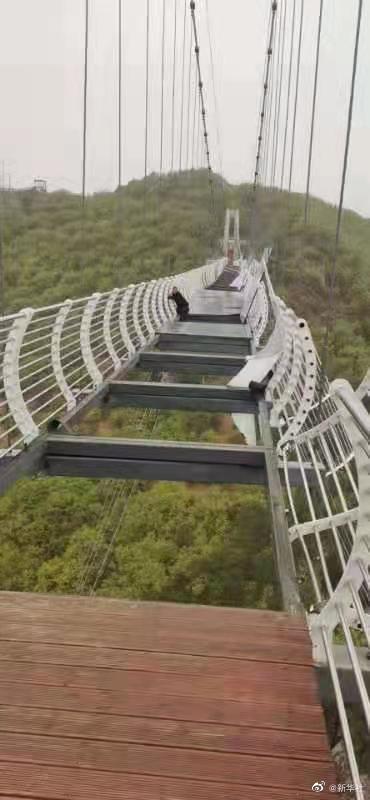Tourist stranded on glass bridge triggers safety concerns
Xinhua | Updated: 2021-05-08 16:13

CHANGCHUN -- A tourist was stranded on a glass-bottomed bridge on Friday at a resort in Northeast China's Jilin province after it was damaged by a gale, raising public concerns over the safety of the growing number of glass bridges across the country.
Several pieces of deck glass of the 100-meter-high bridge were blown off by the wind gusting at a speed of up to 150 km per hour around 12:45 pm at the Piyan Mountain in the city of Longjing, according to the city government.
Under the joint rescue efforts of firefighters, police, and forestry and tourism personnel, the male tourist successfully crawled to safety at 1:20 pm.
He has been sent to a hospital and is receiving psychological counseling.
Although no casualties were reported, the incident has drawn many discussions online, with over 4 million views on Twitter-like Sina Weibo.
"This is exactly why I dare not step on a bridge like that," wrote a netizen named "Wadetian."
"How often did the bridge undergo maintenance?" another netizen inquired.
Glass-bottomed bridges are becoming increasingly popular in China's mountain resorts as a way to attract tourists seeking novelty and adventure.
According to Earth magazine published by the Geological Museum of China, at least 60 glass-bottomed bridges had been or were being built across the country as of late 2016.
In mountainous provinces like Jiangxi, Hunan and Yunnan, glass bridges are particularly common. The most famous is at Zhangjiajie, a tourist destination in Hunan, where a 430-meter-long, six-meter-wide bridge hangs between two steep cliffs 300 meters above the ground.
"So many glass deck bridges have been built in recent years and are very popular with tourists. But how can we ensure their safety?" said a netizen surnamed Li, who is identified as a doctor in Southwest China's Sichuan province.
Some local governments have already put in place guidelines to forestall the potential hazards. North China's Hebei province released in 2018 technical standards for glass bridges and walkways at scenic areas, providing specific guidelines for materials, location, design, construction as well as the use of such bridges and walkways.
For example, glass bridges should not be built in areas with high seismic activity and must be closed during bad weather and natural disasters, and the number of pedestrians on such bridges and walkways will be limited to no more than three per square meter, according to the guidelines.
The Piyan Mountain resort has now been closed.
The Longjing city government will carry out a comprehensive safety inspection of all tourist attractions, and an investigation into the case is underway.
























